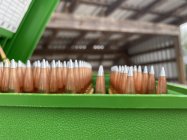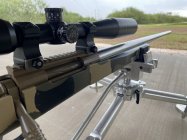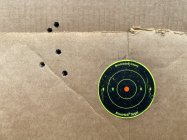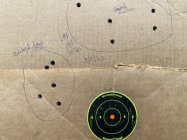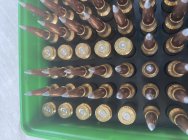You are using an out of date browser. It may not display this or other websites correctly.
You should upgrade or use an alternative browser.
You should upgrade or use an alternative browser.
190 A-tips, seating depth
- Thread starter bulaman
- Start date
I shoot A-Tips in a number of calibers including (mainly) 7mm. If you are used to jumping bullets in a certain gun in order to shoot small, you may need to double or triple (or more) that jump. If you touch or are close to the lands, trying to avoid the donut or powder compression, you will probably never be happy with the results.
I don’t think any powder choice will produce good groups until the jump is very significant. Once you reach that depth, erring on the side of a deeper seating, if in doubt, does not seem to hurt group size in my experience, and peak pressure goes down. We are predisposed to avoid seating into or past the junction, but that accuracy reservation is overstated. (I try to alter brass as little as possible for smooth bolt close, though, so my brass flow to the donut may be less severe than others. IDK, we all basically handle only our own brass).
.284 is a big ask. You need to get that bullet moving as fast as a 180 in your .284, with a slower burning powder, to see any of the wind bucking gain you are looking for. When I got them shooting in a saum, I put down the early .284 experiments. But now I’m revisiting that combo for midrange, myself, because I’m so stocked up to do it with a .284, slogging through this drought. In practice, either Hornady is optimistic or hand-tipped Berger assumptions are pessimistic on BC, but the true “drift overlap” is a bigger velocity “swath” that we might fall into, than expected.
However, they do like to be pushed hard, meaning that at the velocity where they begin to shoot very accurately, for me, group size does not fall off a cliff by adding somewhat more velocity to that level, in order see markedly less drift than with other bullets. Going too slow for A-Tips to group tight, whether to extend brass or barrel life, is something I have seen come to frustrate others. This is generically true of any bullet heavier than the alternative, though.
I don’t think any powder choice will produce good groups until the jump is very significant. Once you reach that depth, erring on the side of a deeper seating, if in doubt, does not seem to hurt group size in my experience, and peak pressure goes down. We are predisposed to avoid seating into or past the junction, but that accuracy reservation is overstated. (I try to alter brass as little as possible for smooth bolt close, though, so my brass flow to the donut may be less severe than others. IDK, we all basically handle only our own brass).
.284 is a big ask. You need to get that bullet moving as fast as a 180 in your .284, with a slower burning powder, to see any of the wind bucking gain you are looking for. When I got them shooting in a saum, I put down the early .284 experiments. But now I’m revisiting that combo for midrange, myself, because I’m so stocked up to do it with a .284, slogging through this drought. In practice, either Hornady is optimistic or hand-tipped Berger assumptions are pessimistic on BC, but the true “drift overlap” is a bigger velocity “swath” that we might fall into, than expected.
However, they do like to be pushed hard, meaning that at the velocity where they begin to shoot very accurately, for me, group size does not fall off a cliff by adding somewhat more velocity to that level, in order see markedly less drift than with other bullets. Going too slow for A-Tips to group tight, whether to extend brass or barrel life, is something I have seen come to frustrate others. This is generically true of any bullet heavier than the alternative, though.
Last edited:
Some instant feedback. I’m at the range, had planned to shoot today. I needed to shoot this new McMillan stock anyway, which has a .284 / bartlein 5r / 36”. I’m shooting A-Tips that I last put away in .284 maybe 18 months or more ago.
Based on my own advice, and a great many more A-Tips down the road, I simply eyeballed a generous reseating down of the first 30 bullets.
Based on my own advice, and a great many more A-Tips down the road, I simply eyeballed a generous reseating down of the first 30 bullets.
Attachments
Jump A-Tips. A lot. The brass today was softer Norma and it looks perfect, with ejecting bolt. My load was 57.0 grains of RE 25.
The shallow seated bullets don’t compare in group size at all. I had dialed right a minute to prevent overlap.
Also, I’m adding a picture of the brass to show the shallow seated bullets did increase pressure evidenced by the last primer, especially. They hit higher, as well.
The shallow seated bullets don’t compare in group size at all. I had dialed right a minute to prevent overlap.
Also, I’m adding a picture of the brass to show the shallow seated bullets did increase pressure evidenced by the last primer, especially. They hit higher, as well.
Attachments
Last edited:
Ned Ludd
Silver $$ Contributor
Exactly how many thousandths are in an "eyeball"? I'm assuming that is a standardized measurement...Based on my own advice, and a great many more A-Tips down the road, I simply eyeballed a generous reseating down of the first 30 bullets...
Deep seating has also helped me with their 250’s. The 6’s seem more flexible but also like a big jump. Their small .22’s start to push what I’ll pay for a .22, especially because they aren’t much cheaper than 250’s. They are good but so are others.
I had these bullets loaded originally just off a soft touch of the lands of a standard spec .284 PTG reamer. Although they weren’t loaded for that barrel, they were loaded for the same reamer that chambered that barrel. My primary open actions are all the same, Surgeon XL, so barrels can be stacked up and wait. When it comes to throating barrels with a unithroater, although I have them, I would rather pick door number two on Cortina’s barrel break-in door choices. (I just can’t do it, - that’s taking out the metal that determines when barrels are shot out).
I want to say, looking at the difference in level of the tips in the box, I re-seated them 150 to 200/1000th’s deeper than they had been.
Edit velocity: in that length barrel these would be expected to run about 2850, but I got chased out by rain and this was a very brief outing.
If anyone has quickload, I don’t, my charge was 57.0 RE 25, BBL 35.5” to be precise.
I had these bullets loaded originally just off a soft touch of the lands of a standard spec .284 PTG reamer. Although they weren’t loaded for that barrel, they were loaded for the same reamer that chambered that barrel. My primary open actions are all the same, Surgeon XL, so barrels can be stacked up and wait. When it comes to throating barrels with a unithroater, although I have them, I would rather pick door number two on Cortina’s barrel break-in door choices. (I just can’t do it, - that’s taking out the metal that determines when barrels are shot out).
I want to say, looking at the difference in level of the tips in the box, I re-seated them 150 to 200/1000th’s deeper than they had been.
Edit velocity: in that length barrel these would be expected to run about 2850, but I got chased out by rain and this was a very brief outing.
If anyone has quickload, I don’t, my charge was 57.0 RE 25, BBL 35.5” to be precise.
Last edited:
Joseph Jones ctsr
Gold $$ Contributor
I tried .005"-.08" in .005" increments and ended up the best at .015", this is in a 7-300prc @ 3250fps with a 1-8 Krieger 30"bbl. I had a nice node at 3310fps but blew a couple bullets up so I backed it down to 3250fps and haven't had any problems.
I found different results than Davejoe..I know his methods as we exchange info..
My rig is
7mm RSAUM
1 in 8.25 t bartlien finished at 30 inches throated for 184gr hybrids.
190gr Atip approx 5 thousandths jump sat over 59.5grs of N165.
It was a load I guessed and tried at 1000yds which shot about 0.5 mins elevation..
A few weeks later I tried them at 100yds too see how they'd do and it shot a bughole..
I'm not 100 percent sure on velocity but I think there doing 2880fps in cooler temps..
At the UK's current temps in excess of 2900fps.
I held off using them at a gbfca league match but tried them at a club match at 1000yds and won it..
Since then I tried them in a big comp at 1100yds and 1200yds and they served me very well in very tough conditions.
My rig is
7mm RSAUM
1 in 8.25 t bartlien finished at 30 inches throated for 184gr hybrids.
190gr Atip approx 5 thousandths jump sat over 59.5grs of N165.
It was a load I guessed and tried at 1000yds which shot about 0.5 mins elevation..
A few weeks later I tried them at 100yds too see how they'd do and it shot a bughole..
I'm not 100 percent sure on velocity but I think there doing 2880fps in cooler temps..
At the UK's current temps in excess of 2900fps.
I held off using them at a gbfca league match but tried them at a club match at 1000yds and won it..
Since then I tried them in a big comp at 1100yds and 1200yds and they served me very well in very tough conditions.
Last edited:
Similar threads
- Replies
- 11
- Views
- 17,616
Upgrades & Donations
This Forum's expenses are primarily paid by member contributions. You can upgrade your Forum membership in seconds. Gold and Silver members get unlimited FREE classifieds for one year. Gold members can upload custom avatars.

Click Upgrade Membership Button ABOVE to get Gold or Silver Status.
You can also donate any amount, large or small, with the button below. Include your Forum Name in the PayPal Notes field.
To DONATE by CHECK, or make a recurring donation, CLICK HERE to learn how.

Click Upgrade Membership Button ABOVE to get Gold or Silver Status.
You can also donate any amount, large or small, with the button below. Include your Forum Name in the PayPal Notes field.
To DONATE by CHECK, or make a recurring donation, CLICK HERE to learn how.










